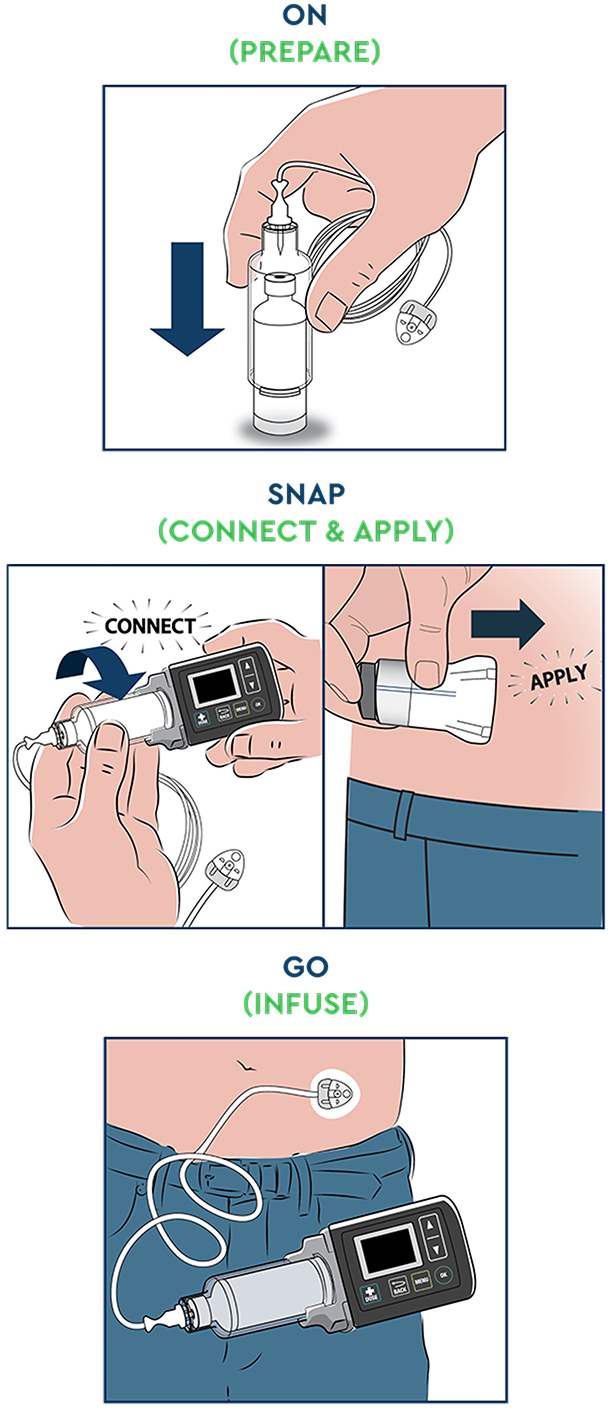IMPORTANT SAFETY INFORMATION
CONTRAINDICATIONS
Concomitant use of ONAPGO with 5HT3 antagonists is contraindicated based on reports of profound hypotension and loss of consciousness
Read More
INDICATION
ONAPGO is indicated for the treatment of motor fluctuations in adults with advanced Parkinson’s Disease (PD).
IMPORTANT SAFETY INFORMATION
CONTRAINDICATIONS
Concomitant use of ONAPGO with 5HT3 antagonists is contraindicated based on reports of profound hypotension and loss of consciousness when ONAPGO was administered with ondansetron.
ONAPGO is contraindicated in patients who have demonstrated hypersensitivity/allergic/anaphylactic reaction to it or any of its excipients, including sulfite (i.e., sodium metabisulfite).
WARNINGS AND PRECAUTIONS
Serious Adverse Reactions After Intravenous Administration:
Subcutaneous use only; thrombus formation and pulmonary embolism have followed intravenous administration.
Nausea and Vomiting:
ONAPGO is known to cause nausea and vomiting (may be severe) when administered at recommended doses. Antiemetics with anti-dopaminergic actions have the potential to worsen PD symptoms. Consider starting therapy, without antiemetics, at 1 mg and titrate based upon effectiveness and tolerance.
Falling Asleep During Activities of Daily Living (ADL) and Somnolence:
Somnolence is commonly associated with ONAPGO. Before initiating treatment, advise patients of risk and assess for factors that can increase it. If significant daytime sleepiness develops or patients fall asleep during ADL, ONAPGO should ordinarily be stopped. If continued, advise patients not to drive and avoid other potentially dangerous activities. There is insufficient information to determine if dose reduction will eliminate episodes of falling asleep during ADL.
Syncope/Hypotension/Orthostatic Hypotension:
ONAPGO may cause orthostatic hypotension at any time, but especially during dose escalation. Patients should avoid alcohol when using ONAPGO and lie down before and after taking sublingual nitroglycerin. Other vasodilators and antihypertensives may also increase hypotensive effects. Monitor blood pressure in patients taking concomitant antihypertensive medications or vasodilators.
Falls: Patients with PD are at risk of falling due to underlying postural instability, possible autonomic instability, and syncope caused by blood pressure lowering effects of PD drugs. ONAPGO may increase risk of falling by simultaneously lowering blood pressure and altering mobility.
Infusion Site Reactions and Infections:
Reactions have been reported including nodules, erythema, hematomas, inflammation, pruritus, swelling, discoloration, hemorrhage, hypersensitivity, induration, edema, pain, rash, or bruising. If an infection is suspected, such as cellulitis, which was reported, the cannula should be removed from the infusion site and a new cannula placed at a new infusion site. In the event of a prolonged interruption of treatment with ONAPGO, the patient should be prescribed oral medications to treat their PD.
Hallucinations/Psychotic-Like Behavior:
Patients with a major psychotic disorder should ordinarily not be treated with ONAPGO due to risk of exacerbating psychosis. Also, certain medications used to treat psychosis may exacerbate symptoms of PD and decrease effectiveness of ONAPGO.
Dyskinesia: ONAPGO may cause dyskinesia or exacerbate pre-existing dyskinesia.
Hemolytic Anemia: Hemolytic anemia requiring hospitalization has been reported. Many cases included positive Coombs test. Severe anemia, angina, and dyspnea have occurred. Some patients were treated with high-dose glucocorticoids or blood transfusions. It can occur at any time after treatment. If a patient develops anemia while taking ONAPGO, consider a hemolytic anemia workup; if it occurs, consider stopping treatment.
Impulse Control/Compulsive Behaviors:
Patients may experience intense urges and inability to control them while taking ONAPGO. Because patients may not recognize these behaviors as abnormal, it is important to specifically ask about new or increased urges with ONAPGO. Consider dose reduction or stopping medication if urges develop.
Cardiac Events: ONAPGO can reduce resting systolic and diastolic blood pressure and may have potential to exacerbate cardiac (and cerebral) ischemia in patients with known cardiovascular and cerebrovascular disease. If patients develop signs and symptoms of cardiac or cerebral ischemia, re-evaluate continued ONAPGO use.
QTc Prolongation and Potential for Proarrhythmic Effects:
There is a dose-related prolongation of QTc interval after apomorphine exposure similar to that achieved with therapeutic doses of ONAPGO. Drugs that prolong QTc have been associated with torsades de pointes and sudden death. Consider risks and benefits of ONAPGO treatment prior to initiating in patients with risk factors for prolonged QTc.
Hypersensitivity: Allergic reactions like urticaria, rash, pruritus, and/or manifestations of angioedema may occur due to ONAPGO or its sulfite excipient sodium metabisulfite, including anaphylactic symptoms and life-threatening or less severe asthmatic episodes. Sulfite sensitivity prevalence is unknown, probably low, and seen more frequently in asthmatic people.
Fibrotic Complications: Retroperitoneal fibrosis, pulmonary infiltrates, pleural effusion, pleural thickening, and cardiac valvulopathy have been reported with ergot-derived dopaminergic agents. Complete resolution does not always occur when drug is stopped. Reactions are believed to be related to ergoline structure. It’s unknown whether non-ergot derived dopamine agonists, such as ONAPGO, can cause these reactions.
Priapism: In clinical studies of intermittent apomorphine injection, painful erections were reported in 3 of 361 men treated with intermittent subcutaneous injection, and one patient withdrew from therapy because of priapism; although no patients in the clinical studies required surgical intervention, severe priapism may require surgical intervention.
ADVERSE REACTIONS
Most common adverse reactions (incidence ≥10% on ONAPGO and at least twice the rate of placebo) were infusion site nodule, nausea, somnolence, infusion site erythema, dyskinesia, headache, and insomnia.
Please see full
Prescribing Information.









